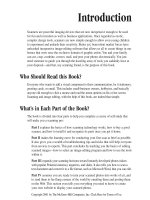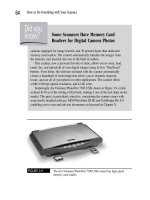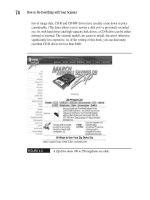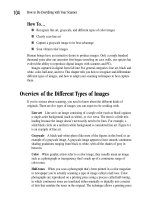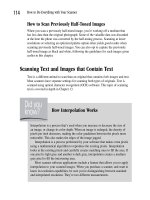How to do everything with PHP (phần 7) pot
Bạn đang xem bản rút gọn của tài liệu. Xem và tải ngay bản đầy đủ của tài liệu tại đây (1.91 MB, 50 trang )
284 How to Do Everything with PHP & MySQL
HowTo8 (8) / How to Do Everything with PHP & MySQL/Vaswani/225795-4/Chapter 14
HowTo8 (8) / How to Do Everything with PHP & MySQL/Vaswani/225795-4/Chapter 14
<body>
<?php
if (!$_POST['submit'])
{
// form not submitted
?>
<form action="<?=$_SERVER['PHP_SELF']?>" method="post">
Username (3-8 char):
<br />
<input type="text" name="username">
<p />
Password (5-8 char):
<br />
<input type="password" name="password">
<p />
Email address:
<br />
<input type="text" name="email">
<p />
Date of Birth:
<br />
Month <input type="text" name="month" size="2">
Day <input type="text" name="day" size="2">
Year <input type="text" name="year" size="4">
<p />
Hobbies (select at least <b>three</b>):
<br />
<input type="checkbox" name="hobbies[]" value="Sports">Sports
<input type="checkbox" name="hobbies[]" value="Reading">Reading
<input type="checkbox" name="hobbies[]" value="Travel">Travel
<input type="checkbox" name="hobbies[]" value="Television">Television
<input type="checkbox" name="hobbies[]" value="Cooking">Cooking
<p />
Subscriptions (Select at least <b>two</b>):
<br />
<select name="subscriptions[]" multiple>
<option value="General">General Newsletter</option>
<option value="Members">Members Newsletter</option>
<option value="Premium">Premium Newsletter</option>
</select>
<p />
<input type="submit" name="submit" value="Sign Up">
</form>
<?php
}
else
{
// array to store the error messages
$ERRORS = array();
ch14.indd 284 2/2/05 3:28:51 PM
TEAM LinG
HowTo8 (8)
CHAPTER 14: Validating User Input 285
HowTo8 (8)
// validate "username" field
$username = !ereg('^([a-zA-Z]){3,8}$', $_POST['username']) ? ↵
$ERRORS[] = 'Enter valid username' : ↵
mysql_escape_string(trim($_POST['username']));
// validate "password" field
$password = !ereg('^([a-z0-9]){5,8}$', $_POST['password']) ? ↵
$ERRORS[] = 'Enter valid password' : trim($_POST['password']);
// validate "email" field
$email = !ereg('^([a-zA-Z0-9_-]+)([\.a-zA-Z0-9_-]+)@([a-zA-Z0-9_-]+)(\ ↵
[a-zA-Z0-9_-]+)+$', $_POST['email']) ? ↵
$ERRORS[] ='Enter valid email address' : trim($_POST['email']);
// validate "date of birth" field
$dob = (!checkdate($_POST['month'], $_POST['day'], $_POST['year']) ? ↵
$ERRORS[] = 'Enter valid date of birth' : ↵
date("Y-m-d", mktime(0, 0, 0, $_POST['month'], $_POST['day'], ↵
$_POST['year'])));
// validate "hobbies" field
$hobbies = (sizeof($_POST['hobbies']) < 3) ? ↵
$ERRORS[] = 'Please select at least three hobbies' : ↵
implode(',', $_POST['hobbies']);
// validate "subscriptions" field
$subscriptions = (sizeof($_POST['subscriptions']) < 2) ? $ERRORS[] = ↵
'Please select at least two subscriptions' : ↵
implode(',', $_POST['subscriptions']);
// verify if there were any errors by checking
// the number of elements in the $ERRORS array
if(sizeof($ERRORS) > 0)
{
// format and display error list
echo "<ul>";
foreach ($ERRORS as $e)
{
echo "<li>$e</li>";
}
echo "</ul>";
die();
}
// no errors?
// connect to database
// save record
}
?>
</body>
</html>
14
ch14.indd 285 2/2/05 3:28:51 PM
TEAM LinG
286 How to Do Everything with PHP & MySQL
Here, for every input test that fails, a new element is added to the global
$ERRORS array. At the end of the tests, before connecting to the database, this
array is checked. If it contains one or more elements, script processing stops and
the errors are displayed to the user as a bulleted list.
If you prefer, you can also log the errors, by using the file_put_
contents() function to dump the array elements to a file. Look at
Chapter 6 for more information on this function.
Summary
Input validation is a critical part of any web application, and this chapter focused
on showing you how to use it to reduce the incidence of errors and illegal values
in your MySQL tables. Techniques covered included checking for required values,
testing the type and length of user input, using regular expressions and pattern-
matching techniques to ensure input conforms to predefined rules, and validating
multiple-choice input and date values.
Of course, input validation is simply too vast a topic to be covered in a single
chapter. To this end, you should read more about it at the following places:
■ The basics of regular expressions, at />community/columns/trog/article.php?id=2
■ More tutorials on regular expressions, at />programming/regular_expressions.html,
and />■ The PHP character type extension, at />■ A discussion of SQL Injection attacks, at />security.database.sql-injection.php
■ Securing user-submitted data, at
.variables.php
■ Input validation on the client using JavaScript, at epoint
.com/article/client-side-form-validation and eco
.ca/~ve3ll/jstutor5.htm
■ Building an extensible form validator, at />community/columns/trog/article.php?id=119
ch14.indd 286 2/2/05 3:28:52 PM
TEAM LinG
Chapter 15
HowTo8 (8)
Formatting
Query Output
ch15.indd 287 2/2/05 3:29:44 PM
Copyright © 2005 by The McGraw-Hill Companies. Click here for terms of use.
TEAM LinG
288 How to Do Everything with PHP & MySQL
HowTo8 (8) / How to Do Everything with PHP & MySQL/Vaswani/225795-4/Chapter 15
HowTo8 (8) / How to Do Everything with PHP & MySQL/Vaswani/225795-4/Chapter 15
A
s a developer, it’s easy to fall in love with your code and to spend hours tuning
it for performance. Remember, though, no matter how engrossing the loops
and swirls of your PHP code are to you, it’s unlikely that the person for whom
you’re developing the application will care about them (or even see them). To the
application end user, all that matters is how user friendly your product is, and how
it will help him or her get things done better. The elegance of your SQL queries
or the impeccable logic of your PHP conditionals will be completely lost on the
end user.
That’s where this chapter comes in. The focus of this chapter is massaging the
output of your MySQL queries so it conforms to the expectations of your users,
and, thereby, becomes more readable and useful. Both PHP and the MySQL RDBMS
come with a number of built-in functions to perform such output formatting. This
chapter describes most of the important ones.
How to…
■ Join multiple fields into a single string, using custom separators
■ Make string or numeric data a uniform size with left/right padding
■ Translate line breaks and special characters in text fields to their HTML
equivalents
■ Format numbers according to local or international currency conventions
■ Use commas or other user-defined characters to make large numeric values
more readable
■ Truncate or round large floating-point values to one or two decimal places
■ Display English-equivalent day and month names for UNIX timestamps or
numeric date/time values
■ Perform simple date arithmetic
■ Break the results of a SELECT query into multiple “pages,” and dynamically
present links to move between pages
Formatting Character Data
A lot of your MySQL data is going to be stored as strings or text blocks, in CHAR,
VARCHAR, or TEXT fields. It’s essential that you know how to manipulate this string
data and adjust it to fit the requirements of your application user interface. Both PHP
ch15.indd 288 2/2/05 3:29:44 PM
TEAM LinG
HowTo8 (8)
CHAPTER 15: Formatting Query Output 289
HowTo8 (8)
and MySQL come equipped with numerous string manipulation functions (in fact,
they overlap in functionality in many places), and the following sections discuss the
important ones.
Concatenating String Values
You learned about string concatenation in PHP in Chapter 3. It’s pretty simple—just
string together the variables you want to concatenate using the PHP concatenation
operation, a period (.). Concatenating fields from a MySQL result set is equally
simple—just assign the field values to PHP variables and concatenate the variables
together in the normal manner.
To see how this works, consider the following table:
mysql> SELECT * FROM users;
+ + + +
| username | fname | lname |
+ + + +
| matt | Matthew | Johnson |
| har56 | Harry | Thompson |
| kellynoor | Kelly | Noor |
| jimbo2003 | Jim | Doe |
| x | Xavier | Belgudui |
+ + + +
5 rows in set (0.00 sec)
Now, assume you need to concatenate the first- and last-name fields into
a single value (a common requirement). Here’s how:
<html>
<head></head>
<body>
<?php
// open connection to MySQL server
$connection = mysql_connect('localhost', 'guest', 'pass') ↵
or die ('Unable to connect!');
// select database for use
mysql_select_db('db2') or die ('Unable to select database!');
15
ch15.indd 289 2/2/05 3:29:45 PM
TEAM LinG
290 How to Do Everything with PHP & MySQL
HowTo8 (8) / How to Do Everything with PHP & MySQL/Vaswani/225795-4/Chapter 15
HowTo8 (8) / How to Do Everything with PHP & MySQL/Vaswani/225795-4/Chapter 15
// create and execute query
$query = 'SELECT fname, lname FROM users';
$result = mysql_query($query) ↵
or die ('Error in query: $query. ' . mysql_error());
// check if records were returned
if (mysql_num_rows($result) > 0)
{
// print HTML table
echo '<ul>';
// iterate over record set
// print each field
while($row = mysql_fetch_object($result))
{
// prints in format "last-name, first-name"
echo '<li>' . $row->lname . ', ' . $row->fname;
}
echo '</ul>';
}
else
{
// print error message
echo 'No rows found!';
}
// once processing is complete
// free result set
mysql_free_result($result);
// close connection to MySQL server
mysql_close($connection);
?>
</body>
</html>
Figure 15-1 illustrates what the output looks like.
There’s another way to do this as well, though. MySQL comes with two built-in
functions—CONCAT() and CONCAT_WS()—which can be used to glue fields
together within the SQL query itself. Take a look at this next snippet from the
MySQL interactive client, which shows these functions in action:
ch15.indd 290 2/2/05 3:29:45 PM
TEAM LinG
HowTo8 (8)
CHAPTER 15: Formatting Query Output 291
HowTo8 (8)
mysql> SELECT CONCAT(fname, lname) FROM users ↵
WHERE username = 'matt';
+ +
| CONCAT(fname, lname) |
+ +
| MatthewJohnson |
+ +
1 row in set (0.02 sec)
mysql> SELECT CONCAT_WS(', ', lname, fname) FROM users ↵
WHERE username = 'matt';
+ +
| CONCAT_WS(', ', lname, fname) |
+ +
| Johnson, Matthew |
+ +
1 row in set (0.00 sec)
FIGURE 15-1 Concatenating string values
15
ch15.indd 291 2/2/05 3:29:45 PM
TEAM LinG
292 How to Do Everything with PHP & MySQL
HowTo8 (8) / How to Do Everything with PHP & MySQL/Vaswani/225795-4/Chapter 15
HowTo8 (8) / How to Do Everything with PHP & MySQL/Vaswani/225795-4/Chapter 15
Note the difference between the two functions: the CONCAT() function
concatenates two or more fields, while the CONCAT_WS() function lets you
specify a string separator between the concatenated field values. Obviously, the
CONCAT_WS() function is used more often; it’s also more forgiving of NULLs
in your table (see the following Caution for more information).
Ensure that none of the fields you’re trying to join with CONCAT() contain
NULLs. This is because the function returns a NULL value if any of its
input arguments are NULL. This quirk can produce unexpected results,
damaging the carefully cultivated look of your output screens. To avoid
this, check for NULL values prior to using the function, and ensure that
your database and validation rules are rigid enough to prevent the entry
of empty/NULL values into fields that aren’t supposed to contain them
(Chapter 14 has more information on how to do this).
The CONCAT_WS() function is more forgiving, simply ignoring NULL
values if it encounters them.
Here’s a rewrite of the previous script that uses these database-level functions
to perform the concatenation and achieve the same result:
<html>
<head></head>
<body>
<?php
// open connection to MySQL server
$connection = mysql_connect('localhost', 'guest', 'pass') ↵
or die ('Unable to connect!');
// select database for use
mysql_select_db('db2') or die ('Unable to select database!');
// create and execute query
$query = "SELECT CONCAT_WS(', ', lname, fname) AS name ↵
FROM users";
$result = mysql_query($query) ↵
or die ('Error in query: $query. ' . mysql_error());
ch15.indd 292 2/2/05 3:29:46 PM
TEAM LinG
HowTo8 (8)
CHAPTER 15: Formatting Query Output 293
HowTo8 (8)
// check if records were returned
if (mysql_num_rows($result) > 0)
{
// print HTML table
echo '<ul>';
// iterate over record set
// print each field
while($row = mysql_fetch_object($result))
{
// prints in format "last-name, first-name"
echo '<li>' . $row->name;
}
echo '</ul>';
}
else
{
// print error message
echo 'No rows found!';
}
// once processing is complete
// free result set
mysql_free_result($result);
// close connection to MySQL server
mysql_close($connection);
?>
</body>
</html>
Padding String Values
In Chapter 14, you read about the PHP trim() function, used to strip leading and
trailing white space from string values prior to testing them for validity or inserting
them into a database. However, PHP also comes with the str_pad() function,
which does just the reverse: it pads strings to a specified length using either white
space or a user-specified character sequence. This can come in handy if you need
to artificially elongate string values for display or layout purposes.
15
ch15.indd 293 2/2/05 3:29:46 PM
TEAM LinG
294 How to Do Everything with PHP & MySQL
HowTo8 (8) / How to Do Everything with PHP & MySQL/Vaswani/225795-4/Chapter 15
HowTo8 (8) / How to Do Everything with PHP & MySQL/Vaswani/225795-4/Chapter 15
Here’s a table containing string values of differing lengths:
mysql> SELECT * FROM ingredients;
+ +
| name |
+ +
| cinnamon |
| ginger |
| red pepper |
| cloves |
| peas |
| tender coconut |
+ +
6 rows in set (0.00 sec)
And here’s some PHP code that demonstrates padding them:
<html>
<head></head>
<body>
<pre>
<?php
// open connection to MySQL server
$connection = mysql_connect('localhost', 'guest', 'pass') ↵
or die ('Unable to connect!');
// select database for use
mysql_select_db('db2') or die ('Unable to select database!');
// create and execute query
$query = "SELECT name FROM ingredients";
$result = mysql_query($query) ↵
or die ('Error in query: $query. ' . mysql_error());
// check if records were returned
if (mysql_num_rows($result) > 0)
{
ch15.indd 294 2/2/05 3:29:46 PM
TEAM LinG
HowTo8 (8)
CHAPTER 15: Formatting Query Output 295
HowTo8 (8)
// iterate over record set
// print each field
while($row = mysql_fetch_object($result))
{
// prints " name"
echo str_pad($row->name, 30, ' ', STR_PAD_LEFT) . '<br />';
}
}
else
{
// print error message
echo 'No rows found!';
}
// once processing is complete
// free result set
mysql_free_result($result);
// close connection to MySQL server
mysql_close($connection);
?>
</pre>
</body>
</html>
Figure 15-2 illustrates what the output looks like.
The str_pad() function takes three parameters: the variable to be padded, the
size it should be padded to, and the character to use for padding. By default, the
function pads the string on the right side. You can alter this default, however, by
passing one of the constants STR_PAD_LEFT or STR_PAD_BOTH to the function
as an optional fourth parameter.
The PHP str_pad() function is functionally equivalent to MySQL’s RPAD()
and LPAD() functions, which pad a string from the right and left, respectively. The
following snippets demonstrate how these functions work:
mysql> SELECT RPAD(name, 20,'_'), LPAD(name, 20, '_') ↵
FROM ingredients LIMIT 0,2;
+ + +
| RPAD(name, 20,'_') | LPAD(name, 20, '_') |
+ + +
| cinnamon____________ | ____________cinnamon |
15
ch15.indd 295 2/2/05 3:29:46 PM
TEAM LinG
296 How to Do Everything with PHP & MySQL
HowTo8 (8) / How to Do Everything with PHP & MySQL/Vaswani/225795-4/Chapter 15
HowTo8 (8) / How to Do Everything with PHP & MySQL/Vaswani/225795-4/Chapter 15
+ + +
| ginger______________ | ______________ginger |
+ + +
2 rows in set (0.00 sec)
A word of caution: if the total length specified in the RPAD() and LPAD()
function call is less than the length of the field value, the value will be truncated.
The next snippet illustrates this:
mysql> SELECT RPAD(name, 5, '_') FROM ingredients ↵
WHERE name = 'cinnamon';
+ +
| RPAD(name, 5, '_') |
+ +
| cinna |
+ +
1 row in set (0.00 sec)
FIGURE 15-2 Padding string values
ch15.indd 296 2/2/05 3:29:47 PM
TEAM LinG
HowTo8 (8)
CHAPTER 15: Formatting Query Output 297
HowTo8 (8)
PHP’s str_pad() function, however, does not truncate strings in
equivalent situations.
Altering String Case
If you need case manipulation, just reach for PHP’s string manipulation API again.
Four useful functions are here: strtolower(), which converts all characters in
a string to lowercase; strtoupper(), which converts all characters to uppercase;
ucfirst(), which converts the first character of a string to uppercase, and the
useful ucwords(), which converts the first character of all the words in a string
to uppercase.
The following example demonstrates these functions, using them on the
different fields of the following table:
mysql> SELECT * FROM customers;
+ + + + + +
| fname | lname | addr | city | email |
+ + + + + +
| David | Johnson | 18 mcgoo place,
ray road | boston | |
| Flora | Bharti | 239/a harkrishna bldg,
j b marg | hyderabad| |
| joe | cool | 15 hill view,
east end road | yorktown | |
+ + + + + +
3 rows in set (0.00 sec)
Here’s the code that reformats all this data to a more consistent casing style:
<html>
<head></head>
<body>
<?php
// open connection to MySQL server
$connection = mysql_connect('localhost', 'guest', 'pass') ↵
or die ('Unable to connect!');
// select database for use
mysql_select_db('db2') or die ('Unable to select database!');
15
ch15.indd 297 2/2/05 3:29:47 PM
TEAM LinG
298 How to Do Everything with PHP & MySQL
HowTo8 (8) / How to Do Everything with PHP & MySQL/Vaswani/225795-4/Chapter 15
HowTo8 (8) / How to Do Everything with PHP & MySQL/Vaswani/225795-4/Chapter 15
// create and execute query
$query = "SELECT * FROM customers";
$result = mysql_query($query) ↵
or die ('Error in query: $query. ' . mysql_error());
// check if records were returned
if (mysql_num_rows($result) > 0)
{
// iterate over record set
// print each field
echo '<table border=1 cellpadding=10>';
echo '<tr><td>Name</td><td>Mailing Address</td> ↵
<td>Email Address</td></tr>';
while($row = mysql_fetch_object($result))
{
echo '<tr>';
echo '<td>' . ucfirst($row->fname) . ' ' . ↵
ucfirst($row->lname) . '</td>';
echo '<td>' . ucwords($row->addr) . '<br />' . ↵
strtoupper($row->city) . '</td>';
echo '<td>' . strtolower($row->email) . '</td>';
echo '</tr>';
}
echo '</table>';
}
else
{
// print error message
echo 'No rows found!';
}
// once processing is complete
// free result set
mysql_free_result($result);
// close connection to MySQL server
mysql_close($connection);
?>
</body>
</html>
Figure 15-3 shows an output sample.
ch15.indd 298 2/2/05 3:29:47 PM
TEAM LinG
HowTo8 (8)
CHAPTER 15: Formatting Query Output 299
HowTo8 (8)
If you want to, you could also do some of this in the query string itself, by using
MySQL’s UCASE() and LCASE() functions. The following snippet illustrates this:
mysql> SELECT CONCAT_WS('\n', UCASE(addr), UCASE(city)) ↵
AS address, LCASE(email) AS email FROM customers;
+ + +
| address | email |
+ + +
| 18 MCGOO PLACE, RAY ROAD | |
| BOSTON | |
| 239/A HARKRISHNA BLDG, J B MARG | |
| HYDERABAD | |
FIGURE 15-3 Changing string case
15
ch15.indd 299 2/2/05 3:29:47 PM
TEAM LinG
300 How to Do Everything with PHP & MySQL
HowTo8 (8) / How to Do Everything with PHP & MySQL/Vaswani/225795-4/Chapter 15
HowTo8 (8) / How to Do Everything with PHP & MySQL/Vaswani/225795-4/Chapter 15
| 15 HILL VIEW, EAST END ROAD | |
| YORKTOWN | |
+ + +
3 rows in set (0.11 sec)
MySQL does not offer functions to capitalize the first character of a
string value. If you need to do this, use the PHP functions described
previously.
Dealing with Special Characters
When it comes to displaying large text blocks on a web page, a PHP developer
must grapple with a number of issues. Special characters need to be protected,
white space and line breaks must be preserved, and potentially malicious HTML
code must be defanged. PHP comes with a number of functions designed to
perform just these tasks.
Repeat Business
MySQL also provides a REPEAT() function, which can be used to display
a string field multiple times. Here’s an example:
mysql> SELECT REPEAT('ho ', 5);
+ +
| REPEAT('ho ', 5) |
+ +
| ho ho ho ho ho |
+ +
1 row in set (0.00 sec)
PHP’s equivalent function is the str_repeat() function.
ch15.indd 300 2/2/05 3:29:48 PM
TEAM LinG
HowTo8 (8)
CHAPTER 15: Formatting Query Output 301
HowTo8 (8)
To illustrate, consider a table containing large blocks of text data, like the
following one:
mysql> SELECT id, data FROM newsdata LIMIT 0,1;
+ + +
| id | data |
+ + +
| 1 | Recently, I put together a Web site and the public actually liked |
my <html> & <javascript>. People |
+ + +
1 row in set (0.00 sec)
Now, here’s how you’d normally retrieve and display this information in
a web page:
<html>
<head></head>
<body>
<font face="Arial" size="-1">
<?php
// open connection to MySQL server
$connection = mysql_connect('localhost', 'guest', 'pass') ↵
or die ('Unable to connect!');
// select database for use
mysql_select_db('db2') or die ('Unable to select database!');
// create and execute query
$query = "SELECT title, data FROM newsdata";
$result = mysql_query($query) ↵
or die ('Error in query: $query. ' . mysql_error());
// check if records were returned
if (mysql_num_rows($result) > 0)
{
// iterate over record set
while($row = mysql_fetch_object($result))
{
echo '<b>' . $row->title . '</b>';
echo '<p />';
15
ch15.indd 301 2/2/05 3:29:49 PM
TEAM LinG
302 How to Do Everything with PHP & MySQL
HowTo8 (8) / How to Do Everything with PHP & MySQL/Vaswani/225795-4/Chapter 15
HowTo8 (8) / How to Do Everything with PHP & MySQL/Vaswani/225795-4/Chapter 15
echo $row->data;
echo '<p />';
}
}
else
{
// print error message
echo 'No rows found!';
}
// once processing is complete
// free result set
mysql_free_result($result);
// close connection to MySQL server
mysql_close($connection);
?>
</font>
</body>
</html>
Figure 15-4 illustrates what this looks like.
If you compare the output of the previous script with the original table data,
you’ll see numerous discrepancies: line breaks and white space are not correctly
rendered, and characters like <,>, and & are interpreted as HTML by the browser
instead of being displayed as is. The integrity of the original text block has, therefore,
been compromised.
To correct these discrepancies, alter the script so it looks like this:
<html>
<head></head>
<body>
<font face="Arial" size="-1">
<?php
// open connection to MySQL server
$connection = mysql_connect('localhost', 'guest', 'pass') ↵
or die ('Unable to connect!');
// select database for use
mysql_select_db('db2') or die ('Unable to select database!');
ch15.indd 302 2/2/05 3:29:49 PM
TEAM LinG
HowTo8 (8)
CHAPTER 15: Formatting Query Output 303
HowTo8 (8)
// create and execute query
$query = "SELECT title, data FROM newsdata";
$result = mysql_query($query) ↵
or die ('Error in query: $query. ' . mysql_error());
// check if records were returned
if (mysql_num_rows($result) > 0)
{
// iterate over record set
while($row = mysql_fetch_object($result))
{
echo '<b>' . $row->title . '</b>';
echo '<p />';
echo nl2br(wordwrap(htmlentities($row->data), 70));
FIGURE 15-4 Printing a text block as is, resulting in display errors
15
ch15.indd 303 2/2/05 3:29:49 PM
TEAM LinG
304 How to Do Everything with PHP & MySQL
HowTo8 (8) / How to Do Everything with PHP & MySQL/Vaswani/225795-4/Chapter 15
HowTo8 (8) / How to Do Everything with PHP & MySQL/Vaswani/225795-4/Chapter 15
echo '<p />';
}
}
else
{
// print error message
echo 'No rows found!';
}
// once processing is complete
// free result set
mysql_free_result($result);
// close connection to MySQL server
mysql_close($connection);
?>
</font>
</body>
</html>
Figure 15-5 illustrates the revised output.
The revised listing uses three new functions.
■ The htmlentities() function takes care of replacing special characters
like ", &, <, and > with their corresponding HTML entity values. This
function is useful to defang user-supplied HTML text and render it incapable
of effecting the display or functionality of your web page. This function also
translates these special characters and prevents them from being interpreted
as HTML code by the browser.
■ Next, the wordwrap() function wraps text to the next line once it reaches
a particular, user-defined size, by inserting the /n newline character at
appropriate points in the text block (these are then converted into HTML
line breaks by the next function). This can be used to set artificial boundaries
on the width of your text display area, and to maintain the integrity of your
page layout.
■ Finally, the nl2br() function automatically preserves newlines in a text
block, by converting them to HTML <br /> elements. This makes it possible
to reproduce the original formatting of the text when it is displayed.
ch15.indd 304 2/2/05 3:29:49 PM
TEAM LinG
HowTo8 (8)
CHAPTER 15: Formatting Query Output 305
HowTo8 (8)
While wordwrap() is a useful way to restrict your text display areas
to specific dimensions, it isn’t the best. Using CSS width and height rules
or constrained <div>s to control the size of your text display areas is
usually more appropriate.
PHP also comes with a strip_tags() function, which enables you
to strip all the HTML and PHP tags out of a string, returning only the
ASCII output. This can be useful if your application has a rigid “no HTML
input” policy.
FIGURE 15-5 Printing a text block, after correcting for special characters and line breaks
15
ch15.indd 305 2/2/05 3:29:50 PM
TEAM LinG
306 How to Do Everything with PHP & MySQL
HowTo8 (8) / How to Do Everything with PHP & MySQL/Vaswani/225795-4/Chapter 15
HowTo8 (8) / How to Do Everything with PHP & MySQL/Vaswani/225795-4/Chapter 15
Formatting Numeric Data
Just as you can massage string values into a number of different shapes, so, too,
can you format numeric data. Both PHP and MySQL come with a full set of functions
to manipulate integer and floating-point numbers, and to format large numeric
values for greater readability.
Using Decimal and Comma Separators
When it comes to formatting numeric values in PHP, there are only two functions:
number_format() and sprintf(). Of these, the former is easier to understand
and use, so let’s begin with that function.
The number_format() function is used to display large numbers with comma
and decimal separators. It can be used to control both the visibility and the appearance
of the decimal digits, as well as the character used as the thousands separator.
To see how this works, consider the following table:
mysql> SELECT accountNumber, accountName, ↵
accountBalance FROM accounts;
+ + + +
| accountNumber | accountName | accountBalance |
+ + + +
| 1265489921 | James D | 2346.00000 |
| 2147483647 | Timothy J | 56347.50000 |
| 5739304575 | Harish K | 996564.87500 |
| 2173467271 | Kingston X | 634238.00000 |
| 2312934021 | Sue U | 34.67000 |
| 1248954638 | Ila T | 5373.81982 |
| 2384371001 | Anil V | 72460.00000 |
| 9430125467 | Katrina P | 100.00000 |
| 1890192554 | Pooja B | 17337.11914 |
| 2388282010 | Sue U | 388883.12500 |
| 2374845291 | Jacob N | 18410.00000 |
+ + + +
11 rows in set (0.05 sec)
Here’s a PHP script that displays this information on a web page, using
number_format() to display account balances with two decimal places and
commas as thousand separators:
ch15.indd 306 2/2/05 3:29:50 PM
TEAM LinG
HowTo8 (8)
CHAPTER 15: Formatting Query Output 307
HowTo8 (8)
<html>
<head></head>
<body>
<?php
// open connection to MySQL server
$connection = mysql_connect('localhost', 'guest', 'pass') ↵
or die ('Unable to connect!');
// select database for use
mysql_select_db('db2') or die ('Unable to select database!');
// create and execute query
$query = "SELECT accountNumber, accountName, accountBalance ↵
FROM accounts";
$result = mysql_query($query) ↵
or die ('Error in query: $query. ' . mysql_error());
// check if records were returned
if (mysql_num_rows($result) > 0)
{
echo '<table border=1 cellpadding=10>';
echo '<tr><td>Number</td><td>Name</td><td>Balance</td></tr>';
// iterate over record set
while($row = mysql_fetch_object($result))
{
echo '<tr>';
echo '<td>' . $row->accountNumber . '</td>';
echo '<td>' . $row->accountName . '</td>';
echo '<td align=right>' . ↵
number_format($row->accountBalance, 2, '.', ',') . '</td>';
echo '</tr>';
}
echo '</table>';
}
else
{
// print error message
echo 'No rows found!';
}
15
ch15.indd 307 2/2/05 3:29:50 PM
TEAM LinG
308 How to Do Everything with PHP & MySQL
HowTo8 (8) / How to Do Everything with PHP & MySQL/Vaswani/225795-4/Chapter 15
HowTo8 (8) / How to Do Everything with PHP & MySQL/Vaswani/225795-4/Chapter 15
// once processing is complete
// free result set
mysql_free_result($result);
// close connection to MySQL server
mysql_close($connection);
?>
</body>
</html>
Figure 15-6 shows the output of this script. Notice how the use of a comma
separator significantly increases the readability of the numbers.
FIGURE 15-6 Formatting numbers with the number_format() function
ch15.indd 308 2/2/05 3:29:50 PM
TEAM LinG

